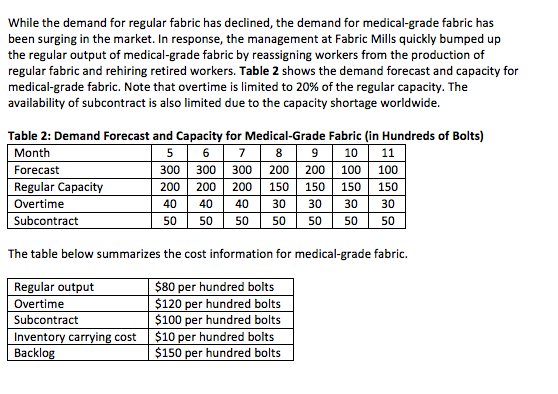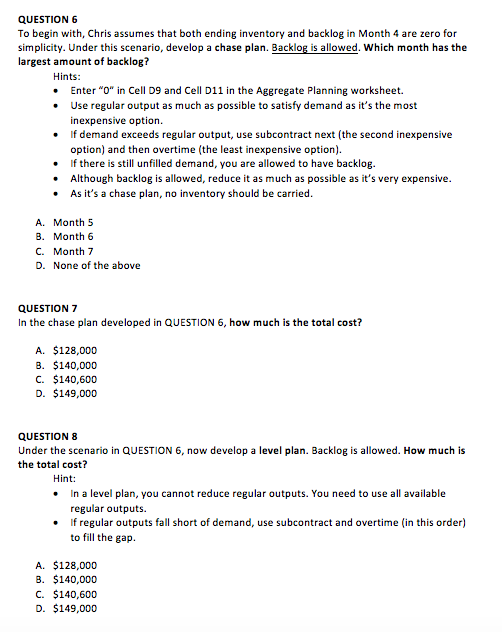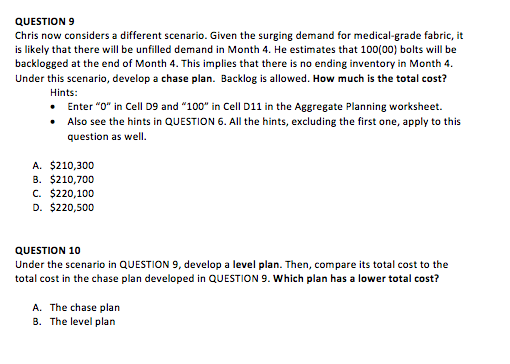


While the demand for regular fabric has declined, the demand for medical-grade fabric has been surging in the market. In response, the management at Fabric Mills quickly bumped up the regular output of medical-grade fabric by reassigning workers from the production of regular fabric and rehiring retired workers. Table 2 shows the demand forecast and capacity for medical-grade fabric. Note that overtime is limited to 20% of the regular capacity. The availability of subcontract is also limited due to the capacity shortage worldwide. Table 2: Demand Forecast and Capacity for Medical-Grade Fabric (in Hundreds of Bolts) Month 5 6 7 8 9 10 11 Forecast 300 300 300 200 200 100 100 Regular Capacity 200 200 200 150 150 150 150 Overtime 40 40 40 30 30 30 30 Subcontract 50 50 50 50 50 50 50 The table below summarizes the cost information for medical-grade fabric. Regular output Overtime Subcontract Inventory carrying cost Backlog $80 per hundred bolts $120 per hundred bolts $100 per hundred bolts $10 per hundred bolts $150 per hundred bolts QUESTION 6 To begin with, Chris assumes that both ending inventory and backlog in Month 4 are zero for simplicity. Under this scenario, develop a chase plan. Backlog is allowed. Which month has the largest amount of backlog? Hints: Enter"0" in Cell D9 and Cell D11 in the Aggregate Planning worksheet. Use regular output as much as possible to satisfy demand as it's the most inexpensive option. If demand exceeds regular output, use subcontract next (the second inexpensive option) and then overtime (the least inexpensive option). If there is still unfilled demand, you are allowed to have backlog. Although backlog is allowed, reduce it as much as possible as it's very expensive. As it's a chase plan, no inventory should be carried. A. Month 5 B. Month 6 C. Month 7 D. None of the above QUESTION 7 In the chase plan developed in QUESTION 6, how much is the total cost? A. $128,000 B. $140,000 C. $140,600 D. $149,000 QUESTION 8 Under the scenario in QUESTION 6, now develop a level plan. Backlog is allowed. How much is the total cost? Hint: in a level plan, you cannot reduce regular outputs. You need to use all available regular outputs. If regular outputs fall short of demand, use subcontract and overtime (in this order) to fill the gap. A. $128,000 3. $140,000 C. $140,600 D. $149,000 QUESTION 9 Chris now considers a different scenario. Given the surging demand for medical-grade fabric, it is likely that there will be unfilled demand in Month 4. He estimates that 100(00) bolts will be backlogged at the end of Month 4. This implies that there is no ending inventory in Month 4. Under this scenario, develop a chase plan. Backlog is allowed. How much is the total cost? Hints: Enter "O" in Cell D9 and "100" in Cell D11 in the Aegregate Planning worksheet. Also see the hints in QUESTION 6. All the hints, excluding the first one, apply to this question as well. A. $210,300 B. $210,700 C. $220,100 D. $220,500 QUESTION 10 Under the scenario in QUESTION 9, develop a level plan. Then, compare its total cost to the total cost in the chase plan developed in QUESTION 9. Which plan has a lower total cost? A. The chase plan B. The level plan While the demand for regular fabric has declined, the demand for medical-grade fabric has been surging in the market. In response, the management at Fabric Mills quickly bumped up the regular output of medical-grade fabric by reassigning workers from the production of regular fabric and rehiring retired workers. Table 2 shows the demand forecast and capacity for medical-grade fabric. Note that overtime is limited to 20% of the regular capacity. The availability of subcontract is also limited due to the capacity shortage worldwide. Table 2: Demand Forecast and Capacity for Medical-Grade Fabric (in Hundreds of Bolts) Month 5 6 7 8 9 10 11 Forecast 300 300 300 200 200 100 100 Regular Capacity 200 200 200 150 150 150 150 Overtime 40 40 40 30 30 30 30 Subcontract 50 50 50 50 50 50 50 The table below summarizes the cost information for medical-grade fabric. Regular output Overtime Subcontract Inventory carrying cost Backlog $80 per hundred bolts $120 per hundred bolts $100 per hundred bolts $10 per hundred bolts $150 per hundred bolts QUESTION 6 To begin with, Chris assumes that both ending inventory and backlog in Month 4 are zero for simplicity. Under this scenario, develop a chase plan. Backlog is allowed. Which month has the largest amount of backlog? Hints: Enter"0" in Cell D9 and Cell D11 in the Aggregate Planning worksheet. Use regular output as much as possible to satisfy demand as it's the most inexpensive option. If demand exceeds regular output, use subcontract next (the second inexpensive option) and then overtime (the least inexpensive option). If there is still unfilled demand, you are allowed to have backlog. Although backlog is allowed, reduce it as much as possible as it's very expensive. As it's a chase plan, no inventory should be carried. A. Month 5 B. Month 6 C. Month 7 D. None of the above QUESTION 7 In the chase plan developed in QUESTION 6, how much is the total cost? A. $128,000 B. $140,000 C. $140,600 D. $149,000 QUESTION 8 Under the scenario in QUESTION 6, now develop a level plan. Backlog is allowed. How much is the total cost? Hint: in a level plan, you cannot reduce regular outputs. You need to use all available regular outputs. If regular outputs fall short of demand, use subcontract and overtime (in this order) to fill the gap. A. $128,000 3. $140,000 C. $140,600 D. $149,000 QUESTION 9 Chris now considers a different scenario. Given the surging demand for medical-grade fabric, it is likely that there will be unfilled demand in Month 4. He estimates that 100(00) bolts will be backlogged at the end of Month 4. This implies that there is no ending inventory in Month 4. Under this scenario, develop a chase plan. Backlog is allowed. How much is the total cost? Hints: Enter "O" in Cell D9 and "100" in Cell D11 in the Aegregate Planning worksheet. Also see the hints in QUESTION 6. All the hints, excluding the first one, apply to this question as well. A. $210,300 B. $210,700 C. $220,100 D. $220,500 QUESTION 10 Under the scenario in QUESTION 9, develop a level plan. Then, compare its total cost to the total cost in the chase plan developed in QUESTION 9. Which plan has a lower total cost? A. The chase plan B. The level plan









